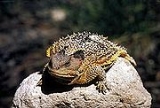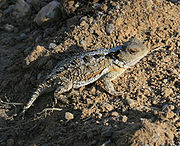
Short-horned Lizard
Encyclopedia
The Short-horned Lizard (Phrynosoma hernandesi) is a small lizard
that occurs in North America
. Like other horned lizards, it is often wrongly called the "Horned Toad" or "Horny Toad," but it is not a toad
at all. It is a reptile
, not an amphibian. It is one of five species of lizards in Canada
. The species name hernandesi honors Francisco Hernández Médico who wrote an early account in 1651 of a Horned Lizard.
Females grow to larger sizes than males: females average some 7 cm (about 2.75 inches) from snout to vent (with a maximum total length of about 15 cm) and weigh about 18 g
, whereas males have an SVL of only about 5 cm and weigh on the average about 10 g.
s, but will also take an occasional grasshopper
or beetle
. Often, they can be found sitting in the vicinity of ant nests or trails. They are diurnal creatures being most active during mid-day and burrowing at night. They rely extensively on camouflage
to avoid predators. If provoked, some horned lizards can build up blood pressure in regions behind their eyes and accurately squirt their blood
at attacking predators, which will deter Canids from continuing their attack. It is rare for Horned Lizards to squirt blood at humans however, reserving this unique defense primarily for Canids (i.e. foxes, coyotes, dogs) which have a strong reaction of distaste to the blood. Squirting blood has been observed in Greater Short-Horned lizards but has not been observed in Pygmy Short-Horned Lizards.
 The Short-horned Lizard is the most widely distributed lizard in North America
The Short-horned Lizard is the most widely distributed lizard in North America
and occurs in the widest range of habitats
: West into central Nevada
, East into North
and South Dakota
, North to Southern Saskatchewan
and Alberta
and then South into the Texas Panhandle
and into central Mexico
. This species of lizard is mostly an arid mountain
dweller living in the range of 900-11,300 feet (170–3440 m). It is the only member of its genus
in Wyoming
, which counts Phrynosoma as its state reptile.
Lizard
Lizards are a widespread group of squamate reptiles, with nearly 3800 species, ranging across all continents except Antarctica as well as most oceanic island chains...
that occurs in North America
North America
North America is a continent wholly within the Northern Hemisphere and almost wholly within the Western Hemisphere. It is also considered a northern subcontinent of the Americas...
. Like other horned lizards, it is often wrongly called the "Horned Toad" or "Horny Toad," but it is not a toad
Toad
A toad is any of a number of species of amphibians in the order Anura characterized by dry, leathery skin , short legs, and snoat-like parotoid glands...
at all. It is a reptile
Reptile
Reptiles are members of a class of air-breathing, ectothermic vertebrates which are characterized by laying shelled eggs , and having skin covered in scales and/or scutes. They are tetrapods, either having four limbs or being descended from four-limbed ancestors...
, not an amphibian. It is one of five species of lizards in Canada
Lizards in Canada
This is a list of the reptiles species recorded in Canada. There are relatively few reptiles in Canada, as only a limited number of species have been able to adapt to the diverse, generally colder Canadian climate. Most species are confined to the southernmost parts of the country...
. The species name hernandesi honors Francisco Hernández Médico who wrote an early account in 1651 of a Horned Lizard.
Identifiction
The Greater Short-Horned Lizard (Phrynosoma hernandesi) is often mistaken for its close relative the Pygmy Short-Horned Lizard (Phrynosoma douglasii) which has the same basic body type consisting of small pointed scales around the head and back. Until recent mitochondrial DNA evidence, P. hernandesi was considered to be the same species as P. douglasii. They are now considered distinct species with the Pygmy Horned Lizard (P. douglasii) occupying the northwest portion of the United States and extreme southern British Columbia. When placed together the two are easily distinguished at full size, the Pygmy Horned Lizard being much smaller. P. hernandesi is a highly variable species with different geographic populations exhibiting differences in color, pattern and size with some authorities describing five subspecies. The Short-Horned Lizard ranges in size from 2-5 inches from snout to vent (4.5-12.4 centimeters) in length and is a flat-bodied, squat lizard with short spines crowning the head. They have a snub-nosed profile and short legs. The trunk is fringed by one row of pointed scales, while the belly scales are smooth. The color is gray, yellowish, or reddish-brown, and there are two rows of large dark spots on the back. When threatened or aggressive, their colors become more intense.Females grow to larger sizes than males: females average some 7 cm (about 2.75 inches) from snout to vent (with a maximum total length of about 15 cm) and weigh about 18 g
Gram
The gram is a metric system unit of mass....
, whereas males have an SVL of only about 5 cm and weigh on the average about 10 g.
Behavior
Short-horned Lizards are "sit-and-wait" predators. They feed primarily on antAnt
Ants are social insects of the family Formicidae and, along with the related wasps and bees, belong to the order Hymenoptera. Ants evolved from wasp-like ancestors in the mid-Cretaceous period between 110 and 130 million years ago and diversified after the rise of flowering plants. More than...
s, but will also take an occasional grasshopper
Grasshopper
The grasshopper is an insect of the suborder Caelifera in the order Orthoptera. To distinguish it from bush crickets or katydids, it is sometimes referred to as the short-horned grasshopper...
or beetle
Beetle
Coleoptera is an order of insects commonly called beetles. The word "coleoptera" is from the Greek , koleos, "sheath"; and , pteron, "wing", thus "sheathed wing". Coleoptera contains more species than any other order, constituting almost 25% of all known life-forms...
. Often, they can be found sitting in the vicinity of ant nests or trails. They are diurnal creatures being most active during mid-day and burrowing at night. They rely extensively on camouflage
Camouflage
Camouflage is a method of concealment that allows an otherwise visible animal, military vehicle, or other object to remain unnoticed, by blending with its environment. Examples include a leopard's spotted coat, the battledress of a modern soldier and a leaf-mimic butterfly...
to avoid predators. If provoked, some horned lizards can build up blood pressure in regions behind their eyes and accurately squirt their blood
Blood squirt
Blood squirt is the effect when an artery, a blood vessel in the human body , is cut...
at attacking predators, which will deter Canids from continuing their attack. It is rare for Horned Lizards to squirt blood at humans however, reserving this unique defense primarily for Canids (i.e. foxes, coyotes, dogs) which have a strong reaction of distaste to the blood. Squirting blood has been observed in Greater Short-Horned lizards but has not been observed in Pygmy Short-Horned Lizards.
Reproduction
The mating season for this species is in spring (May to June). They are viviparous, meaning they give birth to live young: the female will birth 5 to 48 offspring from July to September. The young will measure about 24 mm from snout to vent and weigh each about one gram. The young have no horns yet and are able to take care of themselves within a few hours; they are not able to fully crawl until they are a day old. Males will become sexually active after their first year of life and females generally take two years before they can start reproducing.Distribution

North America
North America is a continent wholly within the Northern Hemisphere and almost wholly within the Western Hemisphere. It is also considered a northern subcontinent of the Americas...
and occurs in the widest range of habitats
Habitat (ecology)
A habitat is an ecological or environmental area that is inhabited by a particular species of animal, plant or other type of organism...
: West into central Nevada
Nevada
Nevada is a state in the western, mountain west, and southwestern regions of the United States. With an area of and a population of about 2.7 million, it is the 7th-largest and 35th-most populous state. Over two-thirds of Nevada's people live in the Las Vegas metropolitan area, which contains its...
, East into North
North Dakota
North Dakota is a state located in the Midwestern region of the United States of America, along the Canadian border. The state is bordered by Canada to the north, Minnesota to the east, South Dakota to the south and Montana to the west. North Dakota is the 19th-largest state by area in the U.S....
and South Dakota
South Dakota
South Dakota is a state located in the Midwestern region of the United States. It is named after the Lakota and Dakota Sioux American Indian tribes. Once a part of Dakota Territory, South Dakota became a state on November 2, 1889. The state has an area of and an estimated population of just over...
, North to Southern Saskatchewan
Saskatchewan
Saskatchewan is a prairie province in Canada, which has an area of . Saskatchewan is bordered on the west by Alberta, on the north by the Northwest Territories, on the east by Manitoba, and on the south by the U.S. states of Montana and North Dakota....
and Alberta
Alberta
Alberta is a province of Canada. It had an estimated population of 3.7 million in 2010 making it the most populous of Canada's three prairie provinces...
and then South into the Texas Panhandle
Texas Panhandle
The Texas Panhandle is a region of the U.S. state of Texas consisting of the northernmost 26 counties in the state. The panhandle is a rectangular area bordered by New Mexico to the west and Oklahoma to the north and east...
and into central Mexico
Mexico
The United Mexican States , commonly known as Mexico , is a federal constitutional republic in North America. It is bordered on the north by the United States; on the south and west by the Pacific Ocean; on the southeast by Guatemala, Belize, and the Caribbean Sea; and on the east by the Gulf of...
. This species of lizard is mostly an arid mountain
Mountain
Image:Himalaya_annotated.jpg|thumb|right|The Himalayan mountain range with Mount Everestrect 58 14 160 49 Chomo Lonzorect 200 28 335 52 Makalurect 378 24 566 45 Mount Everestrect 188 581 920 656 Tibetan Plateaurect 250 406 340 427 Rong River...
dweller living in the range of 900-11,300 feet (170–3440 m). It is the only member of its genus
Genus
In biology, a genus is a low-level taxonomic rank used in the biological classification of living and fossil organisms, which is an example of definition by genus and differentia...
in Wyoming
Wyoming
Wyoming is a state in the mountain region of the Western United States. The western two thirds of the state is covered mostly with the mountain ranges and rangelands in the foothills of the Eastern Rocky Mountains, while the eastern third of the state is high elevation prairie known as the High...
, which counts Phrynosoma as its state reptile.

